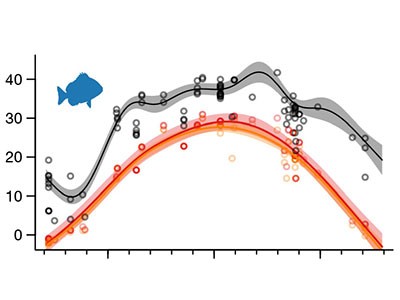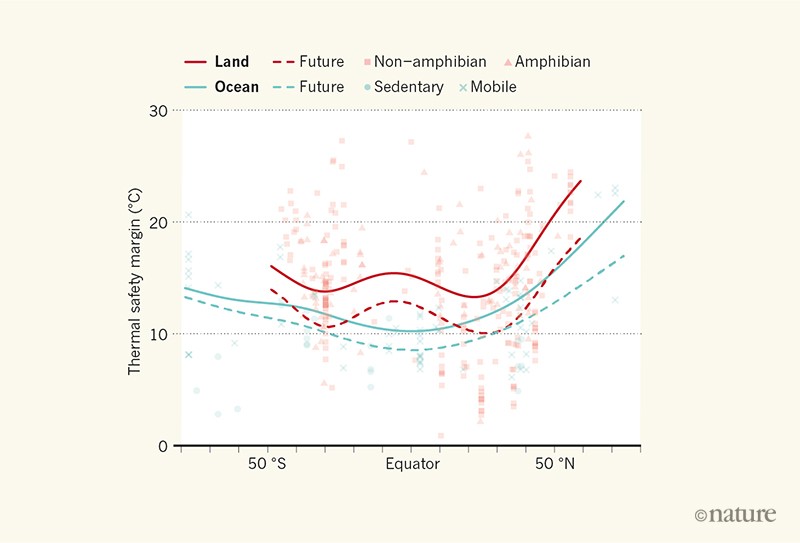NEWS AND VIEWS
25 APRIL 2019Anthony J. Richardson & David S. Schoeman
PDF version
The impact of climate change on biodiversity is a pressing concern. A study now combines experimental data with careful modelling to compare the vulnerability to warming of animal species on land and in the ocean.
Ecologists, conservationists and policymakers are struggling to understand how much of a threat climate change poses to Earth’s biodiversity — estimated to be some 3 million to 100 million species1 — and what to do about that threat. Knowing whether terrestrial or marine species are more vulnerable to climate change, as well as how the risks vary with latitude, could inform the deployment of limited conservation resources, nationally and globally. Writing in Nature, Pinsky et al.2combine robust experimental data with a careful model-based approach to compare the vulnerability of biodiversity to warming across latitudes on land and in the ocean.

Read the paper: Greater vulnerability to warming of marine versus terrestrial ectotherms
There is contradictory evidence about the relative vulnerability to warming of land and ocean animals. Terrestrial species could be at greater risk because they are less able to adapt to new climatic conditions3 and because they are exposed to higher extreme temperatures than are ocean-dwelling species. But marine species could be more affected because temperature strongly controls their geographic limits4, nutrient supplies5 and oxygen availability6.
Temperature extremes, rather than average temperatures, are an important determinant of population survival at the warm edge of a species’ temperature range7. Guided by this evidence, Pinsky et al. calculated the thermal safety margin — defined as the difference between the highest temperature at which an animal can survive (its maximum thermal tolerance) and the maximum body temperature that it will effectively experience under natural conditions — for 387 species of ectothermic animal, which rely on external heat to maintain body temperature. The authors calculated two versions of the thermal safety margin for each species: one for when the animal is fully exposed to heat and one for when it is in a thermal refuge. Terrestrial thermal refuges include microclimates such as shade under a tree or rock, whereas marine thermal refuges comprise deeper, cooler waters.
Pinsky et al. found that there are no thermal safety margins for land-dwelling ectotherms when they have no access to thermal refuges, whereas such margins exist for their ocean-dwelling counterparts. This suggests that land species might be more at risk from climate change than ocean species are. However, when thermal refuges were taken into account, the situation was reversed, with the thermal safety margins being broader for species on land than for those in the ocean (Fig. 1). This implies that marine species might actually be more at risk.

Figure 1 | Thermal safety margins for land and ocean animals that can access thermal refuges. Pinsky et al.2 calculated the thermal safety margin — defined as the difference between the maximum temperature that a species can tolerate and the maximum temperature that it will experience — for 387 ectothermic animal species, which rely on external heat to maintain their body temperature. The authors took into account the ability of animals to access thermal refuges, which are areas in their habitat where they can cool down. Individual data points for different types of animal and solid lines show the present conditions, whereas dashed lines are an estimate of the situation in the year 2100 under the representative concentration pathway 8.5 (RCP8.5) scenario of predicted greenhouse-gas concentration trajectories. The narrower, in general, thermal safety margins in the ocean suggest that warming poses a greater risk to marine species than to those that live on land. (Adapted from Pinsky et al.)
The authors went on to observe that, when thermal refuges were considered, the thermal safety margins of land species were narrowest at the subtropics and widened towards the tropics and poles (Fig. 1), which suggests that warming is a greater threat to subtropical species than to species living in other regions. But, under the same consideration, the thermal safety margins of ocean species were narrowest at the tropics and widened towards the poles, which implies that tropical species are at greater risk from warming. The authors project that with future climate change, terrestrial species in general will continue to have wider thermal safety margins than marine species, but that subtropical terrestrial species will have thermal safety margins as narrow as those of their marine counterparts.
This work has several implications for biodiversity and conservation. First, it predicts that tropical marine species will be most vulnerable to climate change, as they have the narrowest thermal safety margins of all groups of species analysed. The threat to tropical marine species is exacerbated by the predicted replacement of the present highest ocean temperatures by even higher ones, which would cause a rapid poleward shift of the thermal habitat of such species8.
Second, the findings highlight the essential role of thermal refuges in maintaining reasonable thermal safety margins for land animals. The authors observed that the maximum temperature that such animals can tolerate is remarkably flat between the latitudes of 50° N and 50° S. Therefore, variation in thermal safety margins with latitude is largely dictated by the degree of heat to which land animals are exposed in thermal refuges. Intact environments, with trees for shade and accessible water for evaporative cooling, will be crucial for the persistence of terrestrial species in a warming world.
Last, the latitudinal pattern of thermal safety margins suggests that marine species moving north or south from the Equator to escape the warmest environments as they become too hot will typically encounter widening thermal safety margins. This will potentially decrease the vulnerability of such species to temperature extremes. By contrast, land-dwelling tropical species moving polewards as the result of a warming climate might have to run the gauntlet of narrow thermal safety margins in the subtropics (caused by high thermal extremes in these regions) before the margins widen again at higher latitudes. This potentially places terrestrial tropical species at great risk.
Despite the authors’ careful analysis, their work has several limitations, which provide avenues for future research. Pinsky et al. used the best available data, but collecting further data would boost confidence in their findings. Information on the maximum thermal tolerance was available for only a small number of species from a few phyla. Most of the species (318 of the 406 species considered in some parts of the analysis) were terrestrial, and insect biodiversity was severely under-represented. And because the majority of the 88 marine species analysed were fish, information on ocean invertebrate biodiversity was largely missing.
Only 7% of the marine species included in the study were pelagic (living in the water column), meaning that they can seek refuge in deeper, cooler waters when the temperature rises. The remaining 93% of marine species analysed were demersal (living on or near the bottom of the ocean), and so their ability to access thermal refuges is limited. Because pelagic species can access cooler waters, their thermal safety margins are probably greater than those of demersal species. Therefore, the reported differences between terrestrial and marine animals might be better framed as differences between terrestrial species, which are able to access thermal refuges, and demersal marine species, which are not. More work to determine the maximum thermal tolerance of pelagic species is clearly needed.
It is also evident that we have a more sophisticated understanding of thermal refuges on land than in the ocean. Pinsky et al. used several theoretical models to describe the impact of terrestrial microclimates on an animal’s body temperature. There is no similar theoretical framework for marine species and their habitats, so the authors had to make coarser assumptions about how body temperature decreases in thermal refuges. This imbalance in our understanding of land and ocean thermal refuges should be addressed by future studies.
Even using the terms microhabitat or microclimate in the context of marine animals might be misleading because the cooler area below the warm top 200 metres of the ocean is the largest habitat on Earth and has a fairly uniform temperature. The idea that most marine ectotherms spend time in deep waters to offset warm surface conditions might also not be true, because many animals that live in the middle layers of the water column (200–1,000 metres below the surface), such as tuna, spend time close to the ocean surface to warm up9.
The vulnerability of biodiversity to warming is an active area of investigation, and Pinsky et al. have provided valuable insights that will stimulate further research. Their approach could also be used to investigate the vulnerability of biodiversity to other aspects of climate change — including rainfall or pH change — whose extremes might affect species and whose impact might be buffered by refuges.
References
1.May, R. M. Science 329, 41–42 (2010).
Article
Google Scholar
2.Pinsky, M. L., Eikeset, A. M., McCauley, D. J., Payne, J. L. & Sunday, J. M. Nature https://doi.org/10.1038/s41586-019-1132-4 (2019).
Article
Google Scholar
3.Seebacher, F., White, C. R. & Franklin, C. E. Nature Clim. Change5, 61–66 (2015).
Article
Google Scholar
4.Sunday, J. M., Bates, A. E. & Dulvy, N. K. Nature Clim. Change 2, 686–690 (2012).
Article
Google Scholar
5.Richardson, A. J. ICES J. Mar. Sci. 65, 279–295 (2008).
Article
Google Scholar
6.Pörtner, H. O. & Knust, R. Science 315, 95–97 (2007).
PubMed
Article
Google Scholar
7.Harris, R. M. B. et al. Nature Clim. Change 8, 579–587 (2018).
Article
Google Scholar
8.Burrows, M. T. et al. Science 334, 652–655 (2011).
PubMed
Article
Google Scholar
9.Bernal, D., Brill, R. W., Dickson, K. A. & Shiels, H. A. Rev. Fish. Biol. Fisher. 27, 843–880 (2017).


No comments:
Post a Comment